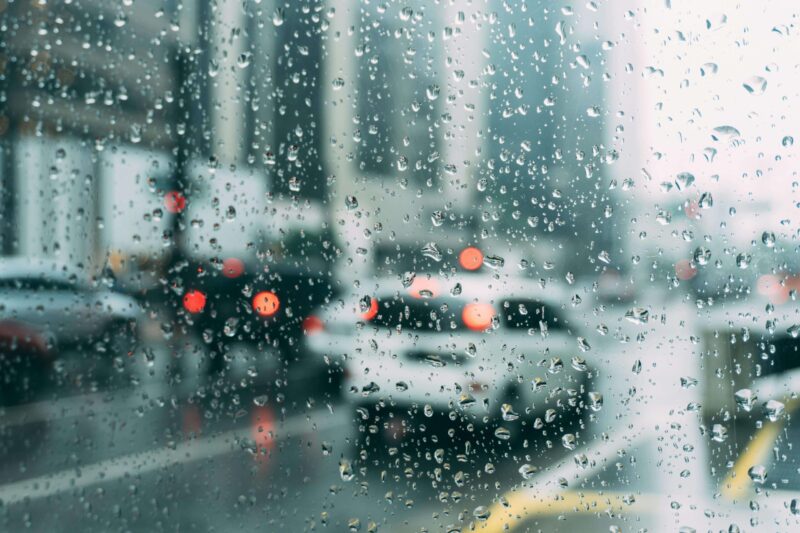The cooler seasons of Autumn and Winter bring weather changes, with some parts of Australia experiencing a transition from blue skies to chillier, wetter conditions. As the darker, damper days arrive, drivers on our roads should take extra caution when driving in the rain. While the best thing to do while the weather is poor is to avoid going out altogether, sometimes it just can’t be helped. That’s why we’ve put together our 12 tips for driving in wet weather, so you can get from A to B as safely as possible, including advice on what to do if you aquaplane or skid on the road.
Our 12 Top Tips for Driving in the Rain
1. Drive slowly and to the condition of the road
Rain affects driving because when the road is wet, it takes longer for you to stop when you brake. Control over your vehicle can also become harder when water mixes with the grit and oil on the road, causing things to get slippery. To avoid aquaplaning when braking, reduce your speed in the rain.
2. Keep your headlights on
Whether it’s day or night, if you’re driving in wet weather, you should have your low-beam headlights on. During the day, this makes you more visible even when the world around you is grey and overcast. At night, low beams are better too, as high-beam headlights are more likely to reflect on the raindrops and reduce your field of vision.
3. De-fog your windscreen
In wet and cold weather, having a car full of people and their body heat can cause your windows to fog up, reducing visibility. Use your air conditioning as a de-mister on the front and back windows and check that your windscreen wipers are working properly before you set off if you’re driving in rainy or icy conditions.
4. Keep your eyes on the road
When driving in the rain, watch out for cyclists, pedestrians, and other road users, as poor weather conditions may significantly reduce your visibility.
5. Brake sooner and easier
Brake sooner and more gently in poor weather to maintain control of your vehicle on wet surfaces and to alert other drivers of your actions.
6. Check your tyres before you set off
If you must drive in wet weather, ensure your tyres are fully inflated and have the correct tread to reduce the risk of skidding and aquaplaning.
7. Stop driving if you need to
If you are tired from concentrating or you can’t see the car in front or the edges of the road, you should pull over in a safe place. Use your hazard warning lights if you’re stopped at the roadside.
8. Don’t drive through big puddles or running water on the road to avoid aquaplaning
You won’t be able to tell how deep the water is or if any debris is hiding under the surface. Driving through water can potentially damage your engine, and you run the risk of aquaplaning if the water is deep or flowing over the road.
9. Avoid driving on unsealed roads
While the winter is a great time to take advantage of the relatively cooler weather for an Outback road trip, if you can’t wait out the downpour, we suggest you try to change your route. Driving on unsealed roads during periods of bad weather can be dangerous, as they are more likely to have hidden potholes, water cover, and sticky mud.

10. Keep a safe distance from other vehicles
Remain at least 4 seconds behind the vehicle in front of you to reduce the risk of a crash and allow enough time for braking. You should also give large vehicles like trucks and buses a wide berth as their splashes may obstruct your visibility.
11. Drive in the tracks of the car in front of you
You can take advantage of the car in front’s water displacement, minimise the amount of water between your tires and the road, and reduce your risk of skidding if you follow the car in front. Just remember to keep your distance to account for the extra time you will take to stop when braking.
12. Allow additional travel time
Plan ahead and give yourself plenty of time to get to your destination – which may include delaying your trip in favour of better weather conditions.
Tips to Avoid Aquaplaning
Aquaplaning happens when your tyres lose grip on the road and travel on the layer of water on top of the road, meaning you can’t steer or brake as easily.
You might not be able to avoid a large puddle, so try not to react too abruptly if you have to travel through it, but decelerate as best you can. You might notice changes to the steering or feel the back of your car swinging out. If this happens, stay calm, brake gently, and don’t accelerate. Keep the steering wheel straight and decelerate until your wheels begin to grip again.
Tips for Recovering from a Skid
Skidding can happen to any driver, no matter how experienced they are, and skidding is especially common when driving in the rain. If you find yourself skidding, apply firm pressure to your brakes and steer into the skid.
Avoidance is the best strategy to stay safe on the roads during bad weather conditions. If you can’t avoid driving in the rain, the best thing to do is to reduce your speed, keep your headlights switched on so that other drivers can see you, keep your attention on the road, and importantly, stop in a safe place if it becomes dangerous to drive any further. For more driving tips or help planning your next great Aussie road trip, check out the Sixt Magazine.